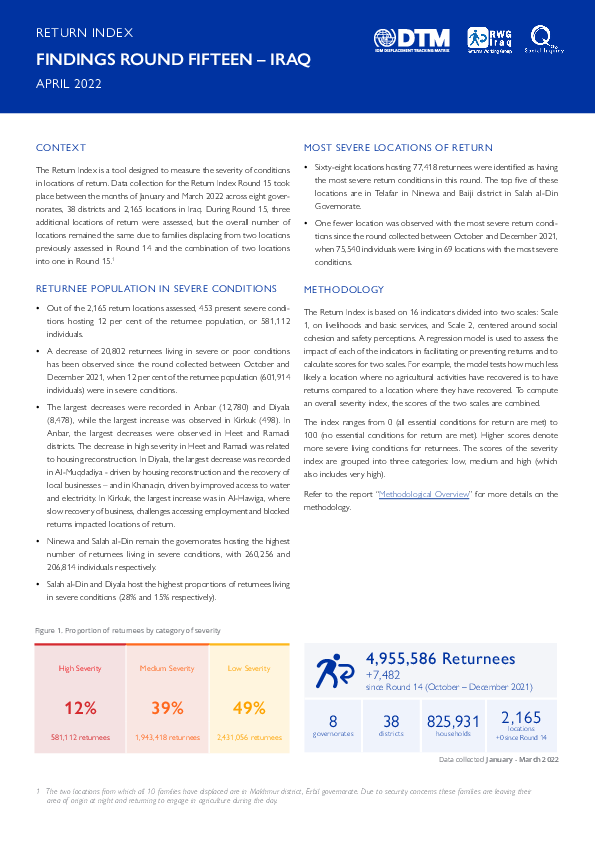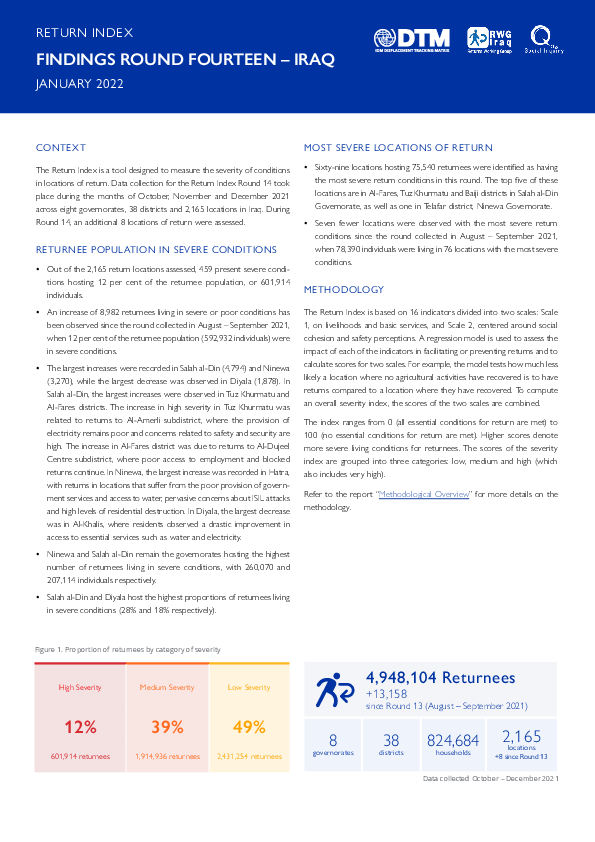-
Countries
-
Data and Analysis
-
Special Focus
-
Crisis Responses
Return Intention

Contact
DTM Iraq, IraqDTM@iom.int
Language
English
Location
Iraq
Period Covered
Jan 01 2022
Mar 31 2022
Activity
- Survey
- Return Intention
- Mobility Tracking
- Baseline Assessment
The Return Index is a tool designed to measure the severity of conditions in locations of return. Data collection for the Return Index Round 15 took place between the months of January and March 2022 across eight governorates, 38 districts and 2,165 locations in Iraq. During Round 15, three additional locations of return were assessed, but the overall number of locations remained the same due to families displacing from two locations previously assessed in Round 14 and the combination of two locations into one in Round 15.

Contact
DTM Europe, DTMMediterranean@iom.int
Language
English
Location
Republic of Moldova
Period Covered
Apr 16 2022
Apr 22 2022
Activity
- Survey
- Return Intention
Since 24 February 2022, an increasing number of people fleeing from Ukraine to the neighbouring countries has been observed, as a result of the war in Ukraine. At the same time, the number of persons exiting the Republic of Moldova and going back to Ukraine has been sustained.
Since 16 April, IOM’s DTM has deployed displacement surveys with Ukrainians and third country nationals (TCNs) before crossing to Ukraine at two main border crossing points (BCPs) – Palanca and Otaci – in the Republic of Moldova. Individual crossings back into Ukraine are not necessarily returnees and conclusions on definitive trends cannot yet be drawn. The sample is not representative of all persons crossing to Ukraine, and results should only be considered as indicative.

Contact
DTM South Sudan, SouthSudanDTM@iom.int
Language
English
Location
South Sudan
Period Covered
Sep 20 2021
Oct 30 2021
Activity
- Survey
- Return Intention
Between September and November 2021, the International Organization for Migration’s Displacement Tracking Matrix (IOM DTM) undertook its second household-level multi-sector assessment of selected urban areas and camps for internally displaced persons (IDPs) in South Sudan. The assessment aims to:
- Quantify the prevalence of vulnerabilities and humanitarian needs across sectors, with a focus on food security, economic vulnerability and nutrition as well as selected indicators on shelter and non-food items (SNFI), education, health, water, hygiene and sanitation (WASH), protection (including child protection and gender-based violence) and mental health and psycho-social support (MHPSS).
- Generate a better understanding of urban displacement and migration, including return and relocation after displacement in South Sudan or abroad.
This survey is part of the country-wide extended Food Security and Nutrition Monitoring System (FSNMS+) assessment in South Sudan, jointly conducted by IOM, the World Food Programme (WFP), the United Nations Children’s Fund (UNICEF), the Food and Agriculture Organization (FAO), the United Nations Office for the Coordination of Humanitarian Affairs (OCHA), REACH and several humanitarian clusters. It was designed to be an independent, crisis-wide and coordinated inter-agency multi-sectoral needs assessment, mandated by the Humanitarian Country Team and endorsed by the Inter- Cluster Coordination Group. Together, the joint findings provide an evidence-base for the Integrated Food Security Phase Classification, the Humanitarian Needs Overview and the Humanitarian Response Plan.
This report presents sectoral findings for the urban area of Juba. Separate profiles will be published for Juba’s IDP camps I and III, Wau’s urban area and Naivasha IDP camp, the urban area of Bentiu / Rubkona and Bentiu IDP camp, Malakal’s urban area and Protection of Civilians (PoC) site and the urban areas of Bor and Yei.

Contact
DTM Europe, DTMMediterranean@iom.int
Language
English
Location
Slovakia
Period Covered
Mar 09 2022
Mar 30 2022
Activity
- Survey
- Return Intention
Since 24 February 2022, an increasing number of Ukrainian refugees and third-country nationals (TCNs) entering Slovakia has been registered as a result of the war in Ukraine. As of 13 April 2022, Slovak authorities have reported 326,997 arrivals from Ukraine, out of whom 301,772 were Ukrainian refugees and 12,817 TCNs.
This report is based on a displacement patterns, needs and intentions survey launched by IOM’s Displacement Tracking Matrix
(DTM). Surveys are conducted face-to-face by trained enumerators with Ukrainian refugees and TCNs fleeing Ukraine after 24
February 2022. This report presents a rapid sectoral needs analysis based on 161 surveys with Ukrainian refugees and TCNs
collected between 9 and 30 March 2022.

Contact
Regional Office Dakar, RODakar-DataResearch@iom.int
Language
English
Activity
- Survey
- Community Perception
- Flow Monitoring Survey
- Return Intention
- Registration
- Flow Monitoring
- Migrants presence
- Mobility Tracking
- Site Assessment
- Event Tracking
- Baseline Assessment
- Points of Entry (PoE)
- Village Assessment
Migration is an integral part of life in West and Central Africa, a long tradition embedded in its historical, economic, social and cultural fabric. The region is a pivotal area of mobility, home to strong intraregional migration and, thanks to its strategic location at the crossroads, close exchanges with other regions.
The second edition of the “A Region on the Move” report provides an overview of population movement trends in West and Central Africa in 2021. It aims to provide a comprehensive overview of mobility in the region and showcase the versatility, multidimensionality and nuances of regional mobility in West and Central Africa.
To that end, the report presents regional mobility using two broad strokes:
- Internal forced displacement: the report provides a detailed analysis of regional displacement numbers, trends and events in 2021, focussing on the five primary security crises affecting West and Central Africa (the Lake Chad Basin Crisis, the Central Sahel Crisis, the Central African Republic Crisis, Nigeria’s North West & North Central Crisis and Cameroons’ Anglophone Crisis)
- Migration flows: the report provides a study of regional migration flows in West and Central Africa. This section makes a distinction between intraregional (internal to West and Central Africa) and inter-regional (with a focus on movements between West and Central Africa and North Africa and Europe) mobility: in each of these sections, the report examines the primary mobility trends and events observed in 2021 as well as the profiles of mobile populations.
The 2021 edition of the report also explores the impacts of the COVID-19 crisis on mobility (including forced displacement and migration flows) and examines the health, socioeconomic, protection and impacts of the COVID-19 pandemic on mobile populations.
The analysis builds on multiple data sources, most of them directly managed and collected by IOM, with external sources used to further complement the mobility picture and provide a holistic understanding of population movement dynamics in West and Central Africa. IOM’s Displacement Tracking Matrix (DTM), which monitors internal forced displacements, migration flows, and characteristics of populations on the move constitutes the main data source for the report.
Contact
Location
Zimbabwe
Activity
- Return Intention
Period Covered
Nov 12 2021 -Jan 24 2022
Population Groups
Survey Methodology
Unit of Analysis Or Observation
Type of Survey or Assessment
Keywords
Geographical Scope
Administrative boundaries with available data
The current dataset covers the following administrative boundaries

Contact
DTM Mediterranean, DTMMediterranean@iom.int
Language
English
Location
Bosnia & Herzegovina
Period Covered
Nov 01 2021
Dec 31 2021
Activity
- Survey
- Flow Monitoring Survey
- Return Intention
- Flow Monitoring
This report presents the summary of the results of the third round of the Displacement Tracking Matrix (DTM) Flow Monitoring Surveys (FMS) implemented in Bosnia and Herzegovina (BiH).
The data was collected from 18 November to 24 December 2021, in five temporary reception centres (TRCs). A total of 319 individual respondents were surveyed.
Le rapport de cartographie des mobilites en Afrique de l'Ouest et du Centre presente les tendances de mobilites et facteurs de migration au sein de la region de l'Afrique de l'Ouest et du Centre (deplacements forces, transhumance, migration de main d'oeuvre, etc), soulignant la diversite et la complexite des mobilites dans la region. Le rapport se base sur les donnees recoltees au travers des outils de collecte de donnees de l'OIM et de donnes de partenaires tels que UNDESA, le HCR et les Ministeres de l'interieur.

Contact
DTM Cameroun, DTMCameroon@iom.int
Language
French
Location
Cameroon
Period Covered
Nov 04 2021
Nov 12 2021
Activity
- Survey
- Return Intention
La Matrice de Suivi des Déplacements (Displacement Tracking Matrix – DTM, en anglais) est un outil mis en place par l’Organisation Internationale pour les Migrations (OIM), qui permet de faire le suivi des déplacements et la mobilité des populations. Elle collecte des informations à différents niveaux, les traite et les diffuse afin de garantir aux acteurs humanitaires, aux gouvernements et autres acteurs intéressés, une meilleure compréhension des mouvements et de l’évolution des besoins des populations déplacées : les facteurs d’influence, les moyens et durées de déplacement, les intentions futures des populations déplacées, leurs conditions de vie et encore bien d’autres éléments sont récoltés auprès de ces populations déplacées.
Ce rapport présente les résultats de la dernière enquête sur les intentions de retour menée auprès des ménages déplacés (Personnes Déplacées Internes (PDI) et réfugiés hors camp) en novembre 2021 dans 6 302 localités de la région de l’Extrême-Nord. Il permet ainsi de mieux comprendre le processus de décision des ménages déplacés, les raisons qui les poussent à partir ou les empêchent de revenir et les conditions nécessaires à un retour durable.

Contact
DTM Iraq, IraqDTM@iom.int
Language
English
Location
Iraq
Period Covered
Oct 01 2021
Dec 31 2021
Activity
- Survey
- Return Intention
- Mobility Tracking
- Baseline Assessment
The Return Index is a tool designed to measure the severity of conditions in locations of return. Data collection for the Return Index Round 14 took place during the months of October, November and December 2021 across eight governorates, 38 districts and 2,165 locations in Iraq. During Round 14, an additional 8 locations of return were assessed.
Pagination
- Previous page
- Page 18
- Next page

